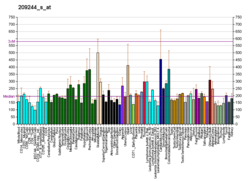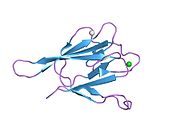| KIF1C | |||||||||||||||||||||||||||||||||||||||||||||||||||
|---|---|---|---|---|---|---|---|---|---|---|---|---|---|---|---|---|---|---|---|---|---|---|---|---|---|---|---|---|---|---|---|---|---|---|---|---|---|---|---|---|---|---|---|---|---|---|---|---|---|---|---|
 | |||||||||||||||||||||||||||||||||||||||||||||||||||
| |||||||||||||||||||||||||||||||||||||||||||||||||||
| Identifiers | |||||||||||||||||||||||||||||||||||||||||||||||||||
| Aliases | KIF1C, LTXS1, SATX2, SAX2, SPAX2, SPG58, kinesin family member 1C | ||||||||||||||||||||||||||||||||||||||||||||||||||
| External IDs | OMIM: 603060; MGI: 1098260; HomoloGene: 4821; GeneCards: KIF1C; OMA:KIF1C - orthologs | ||||||||||||||||||||||||||||||||||||||||||||||||||
| |||||||||||||||||||||||||||||||||||||||||||||||||||
| |||||||||||||||||||||||||||||||||||||||||||||||||||
| |||||||||||||||||||||||||||||||||||||||||||||||||||
| |||||||||||||||||||||||||||||||||||||||||||||||||||
| |||||||||||||||||||||||||||||||||||||||||||||||||||
| Wikidata | |||||||||||||||||||||||||||||||||||||||||||||||||||
| |||||||||||||||||||||||||||||||||||||||||||||||||||
Kinesin-like protein KIF1C is a protein that in humans is encoded by the KIF1C gene. Kif1C is a fast, plus-end directed microtubule motor. It takes processive 8nm steps along microtubules and can generate forces of up to 5 pN. Kif1C transports α5β1-integrins in human cells. Kif1C has been shown to be non-essential in mouse with other proteins able to perform the same function. However, mutations in KIF1C lead to spastic paraplegia and cerebellar dysfunction in humans. These mutations usually result in a total loss of the protein or (partial) loss of function, such as significant lower force output.
Interactions
KIF1C has been shown to interact with PTPN21 and YWHAG. KIF1C is a dimeric molecule that is held in an autoinhibited state by interaction of its stalk with the microtubule binding interface of the motor domain. Upon binding of PTPN21 or the cargo adapter HOOK3 to the KIF1C stalk, the motor domain is released, engages with microtubules and commences transport.
References
- ^ GRCh38: Ensembl release 89: ENSG00000129250 – Ensembl, May 2017
- ^ GRCm38: Ensembl release 89: ENSMUSG00000020821 – Ensembl, May 2017
- "Human PubMed Reference:". National Center for Biotechnology Information, U.S. National Library of Medicine.
- "Mouse PubMed Reference:". National Center for Biotechnology Information, U.S. National Library of Medicine.
- ^ Dorner C, Ciossek T, Müller S, Møller PH, Ullrich A, Lammers R (August 1998). "Characterization of KIF1C, a new kinesin-like protein involved in vesicle transport from the Golgi apparatus to the endoplasmic reticulum". The Journal of Biological Chemistry. 273 (32): 20267–75. doi:10.1074/jbc.273.32.20267. PMID 9685376.
- "Entrez Gene: KIF1C kinesin family member 1C".
- Rogers KR, Weiss S, Crevel I, Brophy PJ, Geeves M, Cross R (September 2001). "KIF1D is a fast non-processive kinesin that demonstrates novel K-loop-dependent mechanochemistry". The EMBO Journal. 20 (18): 5101–13. doi:10.1093/emboj/20.18.5101. PMC 125638. PMID 11566875.
- Siddiqui N, Roth D, Toleikis A, Zwetsloot AJ, Cross RA, Straube A (September 2022). "Force generation of KIF1C is impaired by pathogenic mutations". Current Biology. 32 (17): 3862–3870.e6. Bibcode:2022CBio...32E3862S. doi:10.1016/j.cub.2022.07.029. PMC 9631238. PMID 35961316.
- Theisen U, Straube E, Straube A (December 2012). "Directional persistence of migrating cells requires Kif1C-mediated stabilization of trailing adhesions". Developmental Cell. 23 (6): 1153–66. doi:10.1016/j.devcel.2012.11.005. PMID 23237952.
- Nakajima K, Takei Y, Tanaka Y, Nakagawa T, Nakata T, Noda Y, et al. (February 2002). "Molecular motor KIF1C is not essential for mouse survival and motor-dependent retrograde Golgi apparatus-to-endoplasmic reticulum transport". Molecular and Cellular Biology. 22 (3): 866–73. doi:10.1128/MCB.22.3.866-873.2002. PMC 133549. PMID 11784862.
- Caballero Oteyza A, Battaloğlu E, Ocek L, Lindig T, Reichbauer J, Rebelo AP, et al. (June 2014). "Motor protein mutations cause a new form of hereditary spastic paraplegia". Neurology. 82 (22): 2007–16. doi:10.1212/WNL.0000000000000479. PMC 4105256. PMID 24808017.
- Dor T, Cinnamon Y, Raymond L, Shaag A, Bouslam N, Bouhouche A, et al. (February 2014). "KIF1C mutations in two families with hereditary spastic paraparesis and cerebellar dysfunction". Journal of Medical Genetics. 51 (2): 137–42. doi:10.1136/jmedgenet-2013-102012. PMID 24319291. S2CID 24214406.
- Yücel-Yılmaz D, Yücesan E, Yalnızoğlu D, Oğuz KK, Sağıroğlu MŞ, Özbek U, et al. (June 2018). "Clinical phenotype of hereditary spastic paraplegia due to KIF1C gene mutations across life span". Brain & Development. 40 (6): 458–464. doi:10.1016/j.braindev.2018.02.013. PMID 29544888. S2CID 3892411.
- Marchionni E, Méneret A, Keren B, Melki J, Denier C, Durr A, et al. (2019). "KIF1C Variants Are Associated with Hypomyelination, Ataxia, Tremor, and Dystonia in Fraternal Twins". Tremor and Other Hyperkinetic Movements. 9. doi:10.7916/tohm.v0.641 (inactive 1 January 2025). PMC 6692767. PMID 31413903.
{{cite journal}}: CS1 maint: DOI inactive as of January 2025 (link) - Siddiqui N, Roth D, Toleikis A, Zwetsloot AJ, Cross RA, Straube A (September 2022). "Force generation of KIF1C is impaired by pathogenic mutations". Current Biology. 32 (17): 3862–3870.e6. Bibcode:2022CBio...32E3862S. doi:10.1016/j.cub.2022.07.029. PMC 9631238. PMID 35961316.
- Dorner C, Ullrich A, Häring HU, Lammers R (November 1999). "The kinesin-like motor protein KIF1C occurs in intact cells as a dimer and associates with proteins of the 14-3-3 family". The Journal of Biological Chemistry. 274 (47): 33654–60. doi:10.1074/jbc.274.47.33654. PMID 10559254.
- Siddiqui N, Zwetsloot AJ, Bachmann A, Roth D, Hussain H, Brandt J, et al. (June 2019). "PTPN21 and Hook3 relieve KIF1C autoinhibition and activate intracellular transport". Nature Communications. 10 (1): 2693. Bibcode:2019NatCo..10.2693S. doi:10.1038/s41467-019-10644-9. PMC 6584639. PMID 31217419.
Further reading
- Ishikawa K, Nagase T, Suyama M, Miyajima N, Tanaka A, Kotani H, et al. (June 1998). "Prediction of the coding sequences of unidentified human genes. X. The complete sequences of 100 new cDNA clones from brain which can code for large proteins in vitro". DNA Research. 5 (3): 169–76. doi:10.1093/dnares/5.3.169. PMID 9734811.
- Dorner C, Ullrich A, Häring HU, Lammers R (November 1999). "The kinesin-like motor protein KIF1C occurs in intact cells as a dimer and associates with proteins of the 14-3-3 family". The Journal of Biological Chemistry. 274 (47): 33654–60. doi:10.1074/jbc.274.47.33654. PMID 10559254.
- Rual JF, Venkatesan K, Hao T, Hirozane-Kishikawa T, Dricot A, Li N, et al. (October 2005). "Towards a proteome-scale map of the human protein-protein interaction network". Nature. 437 (7062): 1173–8. Bibcode:2005Natur.437.1173R. doi:10.1038/nature04209. PMID 16189514. S2CID 4427026.
- Kopp P, Lammers R, Aepfelbacher M, Woehlke G, Rudel T, Machuy N, et al. (June 2006). "The kinesin KIF1C and microtubule plus ends regulate podosome dynamics in macrophages". Molecular Biology of the Cell. 17 (6): 2811–23. doi:10.1091/mbc.E05-11-1010. PMC 1474789. PMID 16554367.
- Beausoleil SA, Villén J, Gerber SA, Rush J, Gygi SP (October 2006). "A probability-based approach for high-throughput protein phosphorylation analysis and site localization". Nature Biotechnology. 24 (10): 1285–92. doi:10.1038/nbt1240. PMID 16964243. S2CID 14294292.
- Olsen JV, Blagoev B, Gnad F, Macek B, Kumar C, Mortensen P, et al. (November 2006). "Global, in vivo, and site-specific phosphorylation dynamics in signaling networks". Cell. 127 (3): 635–48. doi:10.1016/j.cell.2006.09.026. PMID 17081983. S2CID 7827573.
External links
- Overview of all the structural information available in the PDB for UniProt: O43896 (Kinesin-like protein KIF1C) at the PDBe-KB.
| PDB gallery | |
|---|---|
This article on a gene on human chromosome 17 is a stub. You can help Misplaced Pages by expanding it. |
| Proteins of the cytoskeleton | |||||||||||||||||||||||||||||||||||||||||||||||||||||
|---|---|---|---|---|---|---|---|---|---|---|---|---|---|---|---|---|---|---|---|---|---|---|---|---|---|---|---|---|---|---|---|---|---|---|---|---|---|---|---|---|---|---|---|---|---|---|---|---|---|---|---|---|---|
| Human |
| ||||||||||||||||||||||||||||||||||||||||||||||||||||
| Nonhuman | |||||||||||||||||||||||||||||||||||||||||||||||||||||
| See also: cytoskeletal defects | |||||||||||||||||||||||||||||||||||||||||||||||||||||





